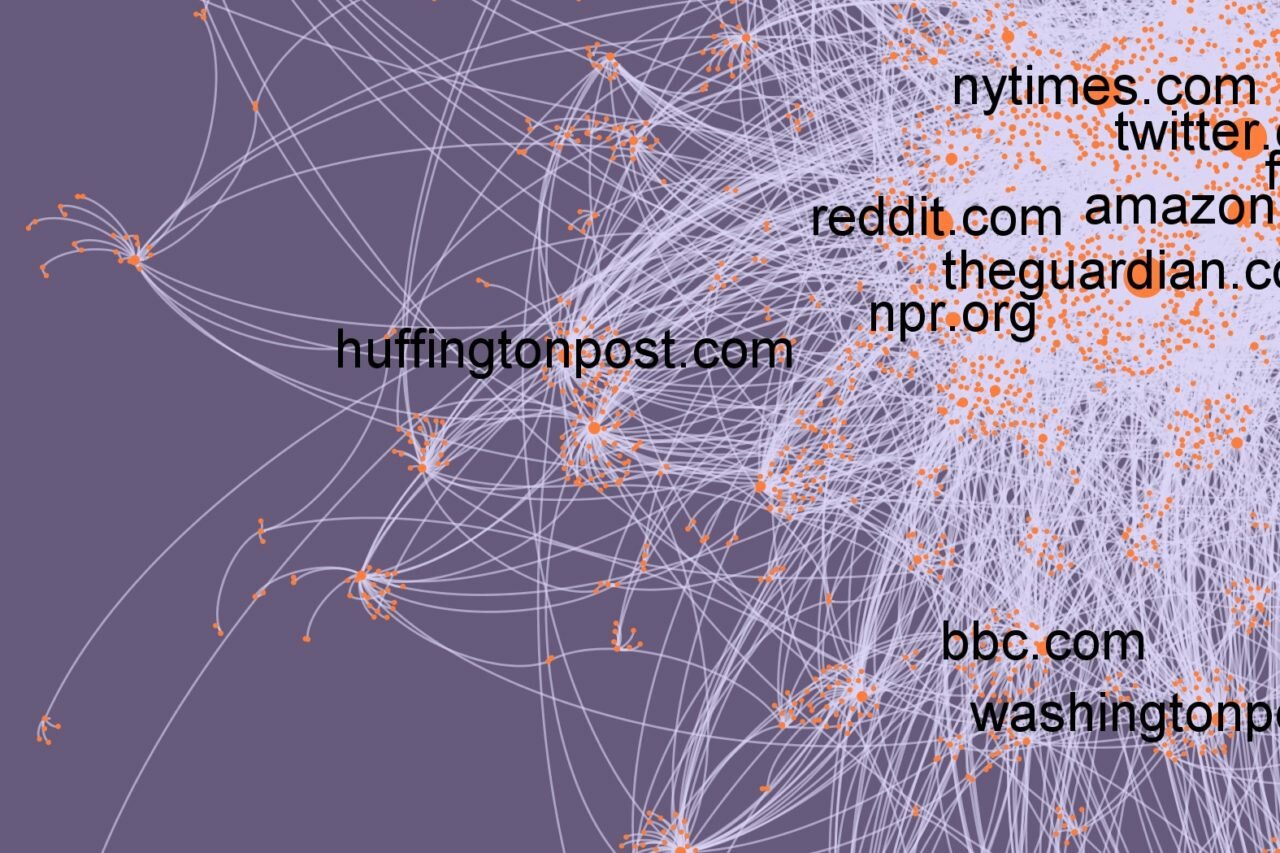Automatic Ideology Recognition
The GDI Gottlieb Duttweiler Institute has tested to what extent the "Tribefinder" software can identify the ideological orientation of Anglo-Saxon media brands.

Most Important Media in the Global Thought Leader Network
by Detlef Gürtler
The current tests for artificial intelligence include the extent to which algorithms and machines are capable of recognising and analysing people and human behaviour – for example, in automatic face recognition. The “Tribefinder” software developed by MIT researcher Peter Gloor tries to draw conclusions from the content oft a Twitter account about the political attitude of the person or institution responsible for this account. The GDI Gottlieb Duttweiler Institute has tested to what extent this software can identify the ideological orientation of Anglo-Saxon media brands.
The beta version of the Tribefinder software provided to GDI assumes four basic ideological positions:
Spiritualist: They trust in their beliefs, and they believe in higher beings and eternal values. They find strength in contemplation, and their behaviour is driven by karma.
Nerd: They believe that progress, science and technology are a blessing. They want to overcome death and colonise Mars. They are fans of globalisation and network with each other in Davos.
Treehugger: They believe in the limits of growth and in the protection of nature. They challenge some elements of technological progress (e.g. gene manipulation) and welcome others (e.g. alternative energies).
Fatherlander: They believe in God and homelands, and they believe their homeland to be the best one. They cling to the good old times, hold the idea of the family in high regard and have little time for foreigners.
The software assigns terms to these four basic positions, which are often used by representatives of the respective orientation – for example, ‘meditation’ by Spiritualists, ‘cool’ by Nerds, ‘sustainable’ by Treehuggers and ‘honour’ by Fatherlanders. The word count in the tweets of an account leads to a score for each of these positions, which add up to 100%.
In order to test the accuracy of the Tribefinder algorithm, the GDI used a chart of the political position of 80 Anglo-Saxon media brands made in September 2015 by journalist Robert Mariani.
Mariani places these media in a four-field matrix, with the x-axis describing the position in the left-right spectrum and the y-axis describes the tonality of the medium – from ‘restrained‘ to ‘insane‘. The four quadrants are accordingly
| left / restrained | right / restrained |
| left / insane | right / insane |
The GDI Gottlieb Duttweiler Institute has not checked or corrected the classification made by Mariani, or adopted it as its own. Both the GDI and other persons or institutions would certainly come to different conclusions in individual cases. The decisive advantage of Mariani‘s matrix for this study is that it has not been made by those who participated in the Tribefinder study – thus preventing bias.
The Twitter accounts of the listed media brands were then evaluated (if available) by the Tribefinder software. The results show that today’s algorithms are already able to identify ideologies:
The five brands with the highest “Fatherlander” value all belong to the “Right / Insane” group: Daily Signal, Infowars, American Thinker, NRO, World Net Daily.
| Media | Category |
Fatherlander – Spiritualist – Nerd – Treehugger
Composition
|
|---|---|---|
| Daily Signal | r / i | |
| Infowars | r / i | |
| American Thinker | r / i | |
| NRO | r / i | |
| WorldNetDaily | r / i |
Colours: Fahterlander, Spiritualist , Nerd, and Treehugger
Abbreviations: r / i = right insane, r / r = right restrained, l / i = left insane, l / r left = restrained
Seven of the 10 media with the highest “Treehugger” value are positioned on the left half of Mariani’s matrix.
| Media | Category |
Treehugger – Spiritualist – Nerd – Fatherlander
Composition
|
|---|---|---|
| Social Matter | r / r | |
| BBC | l / r | |
| IJReview | r / i | |
| MSNBC | l / i | |
| Atlantic | l / r | |
| LATimes | l / r | |
| Fox | r / i | |
| Politico | l / r | |
| Gawker | l / i | |
| Chicago Tribune | l / r |
Eight of the 10 media with the lowest “Treehugger” value are positioned on the right.
| Media | Category |
Treehugger – Spiritualist – Nerd – Fatherlander
Composition
|
|---|---|---|
| Daily Signal | r / i | |
| New Inquiry | l / r | |
| CityAM | r / r | |
| Future Primeval | r / r | |
| American Thinker | r / i | |
| Drudge | r / i | |
| Critical-Theory | l / i | |
| Mitrailleuse | r / r | |
| Infowars | r / i | |
| WSJ | r / r |
The values for the two remaining orientations, Nerd and Spiritualist, showed no significant deviations in the Mariani matrix. This, too, is a plausible result of the automated ideology recognition, since this matrix reflects mainly the positioning in the left-right spectrum. Here, the deviations from the centre are bigger for the Treehuggers (to the left) and the Fatherlanders (to the right).
The Tribefinder software is certainly not yet able to deliver a 100% correct recognition of ideology. However, an approximate screening of the content of individual Twitter accounts is possible. This is particularly helpful when using completely unknown media in order to obtain hints on the account’s potential bias. In this way, the gatekeeper function of channelling and pre-sorting the information stream (‘all the news that’s fit to print’), which previously was fulfilled by media, could be taken over by an algorithm.



